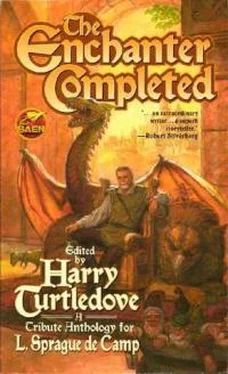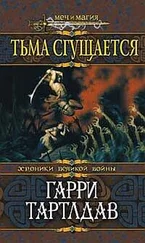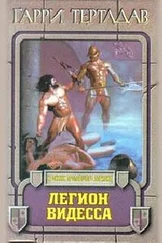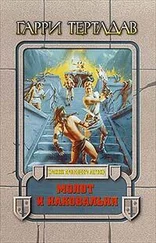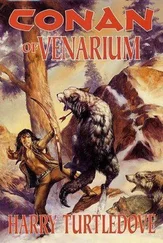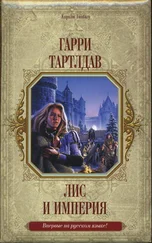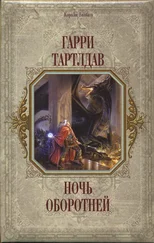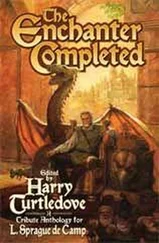Гарри Тертлдав - The Enchanter Completed
Здесь есть возможность читать онлайн «Гарри Тертлдав - The Enchanter Completed» весь текст электронной книги совершенно бесплатно (целиком полную версию без сокращений). В некоторых случаях можно слушать аудио, скачать через торрент в формате fb2 и присутствует краткое содержание. Год выпуска: 2005, ISBN: 2005, Издательство: Baen Books, Жанр: Фантастика и фэнтези, на английском языке. Описание произведения, (предисловие) а так же отзывы посетителей доступны на портале библиотеки ЛибКат.
- Название:The Enchanter Completed
- Автор:
- Издательство:Baen Books
- Жанр:
- Год:2005
- ISBN:0-7434-9904-2
- Рейтинг книги:4 / 5. Голосов: 1
-
Избранное:Добавить в избранное
- Отзывы:
-
Ваша оценка:
- 80
- 1
- 2
- 3
- 4
- 5
The Enchanter Completed: краткое содержание, описание и аннотация
Предлагаем к чтению аннотацию, описание, краткое содержание или предисловие (зависит от того, что написал сам автор книги «The Enchanter Completed»). Если вы не нашли необходимую информацию о книге — напишите в комментариях, мы постараемся отыскать её.
The Enchanter Completed — читать онлайн бесплатно полную книгу (весь текст) целиком
Ниже представлен текст книги, разбитый по страницам. Система сохранения места последней прочитанной страницы, позволяет с удобством читать онлайн бесплатно книгу «The Enchanter Completed», без необходимости каждый раз заново искать на чём Вы остановились. Поставьте закладку, и сможете в любой момент перейти на страницу, на которой закончили чтение.
Интервал:
Закладка:
But everyone was healthy, and science marched on. The seas were drained, which immediately tripled the available land area. (In fifty years the sea bottoms were also full.) Energy which had come from the fusion of marine hydrogen now came by tapping the full energy output of the Sun, through gigantic “mirrors” composed of pure force. The other planets froze, of course, but this no longer mattered, since in the decades that followed they were disintegrated for the sake of the energy at their cores. So was the Sun. Maintaining life on Earth on such artificial standards was prodigal of energy consumption; in time every star in the Galaxy was transmitting its total power output to the Earth, and plans were afoot to tap Andromeda, which would care for all necessary expansion for—thirty years.
At this point a calculation was made.
Taking the weight of the average man at about a hundred and thirty pounds—in round numbers, 6 X 104grammes—and allowing for a continued doubling of population every thirty years (although there was no such thing as a “year” any more, since the Sun had been disintegrated; now a lonely Earth floated aimlessly towards Vega), it was discovered that by the early part of the twenty-first century the total mass of human flesh, bone and blood would be 6 X 1027grams.
This presented a problem. The total mass of the Earth itself was only 5.98 X 1027grams. Already humanity lived in burrows penetrating crust and basalt and quarrying into the congealed nickel-iron core; by the twenty-first century all the core itself would have been transmuted into living men and women, and their galleries would have to be tunneled through masses of their own bodies, a writhing, squeezed ball of living corpses drifting through space.
Moreover simple arithmetic showed that this was not the end. In finite time the mass of human beings would equal the total mass of the Galaxy; and in some further time it would equal and exceed the total mass of all galaxies everywhere.
This state of affairs could no longer be tolerated, and so a project was launched.
With some difficulty resources were diverted to permit the construction of a small but important device. It was a time machine. With one volunteer aboard (selected from the nine hundred trillion who applied) it went back to the year 1. Its cargo was only a hunting rifle with one cartridge, and with that cartridge the volunteer assassinated Snodgrass as he trudged up the Palatine.
To the great (if only potential) joy of some quintillions of never-to-be-born persons, Darkness blessedly fell.
The Garden Gnome Freedom Front
Laura Frankos
Anyone noticing the three young women dining in the café in the Norman village of Saint-Clément would have assumed they were students from the nearby university at Rouen. Theywere students, but they were also commandos in a secret organization devoted to freeing an oppressed people.
“Are all our esteemed members present?” asked Alizon Riand.
Raquel Guibert snorted. “Given that there are only three of us, that should be obvious. Becca, put away the sketchbook and pay attention.”
Becca Milleron lifted her curly head from her work. “Are we ready? I’m nearly finished.” She scrutinized her drawing—a dragon with a perplexed expression somewhat like the artist’s—and bent to add some cross-hatching.
Alizon tapped on a glass with her fork, causing Becca to stop. “Ahem. I hereby call this month’s meeting
of the Garden Gnome Freedom Front to order. Raquel, do you want to give your report first?”
“Sure. Our rivals in Torgon have struck again, no doubt jealous of our successes this summer. They seized a dozen gnomes, along with their wheelbarrows, windmills, hedgehogs, and deer. A week later, the gnomes reappeared in the town square.”
Alizon’s long slender hands gripped the edge of the table. “I’m braced. What did they look like this time?”
“It’s truly depraved. They had been repainted so it looked like they were wearing pinstriped business suits. One poor gnome even had a briefcase. The wheelbarrows were flipped over and painted beige to look like computers. Thank heavens they didn’t turn the hedgehogs into computer mice—something Cinderella’s godmother never dreamed of.”
“Wheelbarrow computers?” asked Becca, trying to envision the scene. “But what about the wheels? Wouldn’t they stick up and spoil the effect?”
“The ceramic wheelbarrow did look dreadful. But two of them were plastic wheelbarrows, so they simply removed the axles. They even stuck squares of clear plastic on them to mimic monitors.”
Alizon shook her head. “Plastic wheelbarrows! How tacky. One could almost applaud our rivals’ actions. After all, they claim they are defending France from kitsch.”
“Taking the gnomes from their gardens and inserting them in the corporate world isnot improving their situation,” said Raquel. “Pinstripes and briefcases! Ours is a much more noble purpose.”
“To free the gnomes from the tyranny of human owners and return them to their native woodland home!” cried Becca.
“Huzzah!” all three cheered, then broke into laughter. The waiter hardly gave them a glance; they were regulars at the nearly deserted café.
In the nineties, many organizations devoted to garden gnomes sprang up in France, rather like mushrooms. A few were meant for aficionados of the ceramic figures, of which there were at least 100 million worldwide. Others, like the rivals in the nearby town of Torgon, snatched gnomes and set them in absurd displays as a protest against tacky art. Still other groups, of a more violent terroristic nature, smashed gnomes to bits. The Garden Gnome Freedom Front had its own specific objectives. Its handbook included sections on the Origins of Gnomes and Their Destiny, the Uselessness of Accessories (including wheelbarrows and deer), Distinguishing Characteristics of Gnomes, and, most important, their treatise, Why Support Gnomish Independence?
The G.G.F.F. had begun as a joke a year before, in 1995, when the three friends contributed to a science fiction fanzine. Alizon, who was majoring in history, and Raquel, whose specialty was folklore, concocted silly ideas for the text. Becca, the artist, illustrated each section. It won them notoriety in the French science fiction community, and Becca got an award for fan art at a convention when she displayed the handbook’s cover painting.
None of them could remember who first suggested making their fictional organization a reality. It was in spring, when they were celebrating the end of examinations with a bit too much wine. Their flat looked over the oldest section of Saint-Clément, filled with small cottages, quaint gardens … and gnomes. One minute they were drinking a fine Bordeaux, the next they were scrambling over stone walls, absconding with bearded ceramic figures. Alizon declared that the best place for the rescued gnomes was a woodland glade. An avid bird watcher, she knew the right spot, some two miles outside the town. Even with her expert guidance, getting there in the dark was hard. Tromping through bracken eradicated the effects of the wine, but the exhilaration returned when they placed the newly independent gnomes in a fairy ring of mushrooms.
They struck two more blows for gnomish liberty over the summer, and on this balmy September day had gathered to plan another mission.
“Next on our agenda: local gnomish doings,” Alizon announced after their giggling subsided. “I’ve spotted two new houses with gnomes in the gardens, on rue Michelet and rue Maréchal-Foch. The benefits of being a bird watcher: nobody knows I’m doing surveillance for our cause with my binoculars.”
Raquel and Becca exchanged looks. “You can’t fool us,” Raquel said at last. “You were out watching birds and accidentally spotted some gnomes.”
Читать дальшеИнтервал:
Закладка:
Похожие книги на «The Enchanter Completed»
Представляем Вашему вниманию похожие книги на «The Enchanter Completed» списком для выбора. Мы отобрали схожую по названию и смыслу литературу в надежде предоставить читателям больше вариантов отыскать новые, интересные, ещё непрочитанные произведения.
Обсуждение, отзывы о книге «The Enchanter Completed» и просто собственные мнения читателей. Оставьте ваши комментарии, напишите, что Вы думаете о произведении, его смысле или главных героях. Укажите что конкретно понравилось, а что нет, и почему Вы так считаете.
